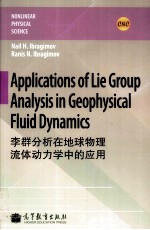

李群分析在地球物理流体动力学中的应用 英文版PDF格式文档图书下载
- 购买点数:10 点
- 作 者:RanisIbragimov NailIbragimov著
- 出 版 社:北京:高等教育出版社
- 出版年份:2011
- ISBN:9787040319545
- 标注页数:215 页
- PDF页数:225 页
PartⅠ Internal Waves in Stratified Fluid 1
1 Introduction 3
2 Governing Equations 5
2.1 Stratification 6
2.2 Linear model for small disturbances 7
2.2.1 Linearization of the boundary conditions 10
2.2.2 Linear boundary value problem 11
2.3 The Boussinesq approximation for nonlinear internal waves in continuously stratified ocean 13
2.3.1 Two-dimensional nonlinear Boussinesq equations 15
2.3.2 Dispersion relation and anisotropic property of internal waves 17
3 Two Model Examples 25
3.1 Generation of internal waves 25
3.1.1 Harmonic tidal flow over a corrugated slope 26
3.1.2 Discussion about the radiation condition 29
3.2 Reflection of internal waves from sloping topography 33
3.2.1 The problem of internal waves impinging on a sloping bottom 34
3.2.2 Direct answer to the question 36
3.2.3 Latitude anomaly as an alternative answer 39
PartⅡ Introduction to Lie Group Analysis 43
4 Calculus of Differential Algebra 47
4.1 Definitions 47
4.1.1 Main variables 47
4.1.2 Total differentiations 48
4.1.3 Differential functions 48
4.1.4 Euler-Lagrange operator 49
4.2 Properties 49
4.2.1 Divergence test 49
4.2.2 One-dimensional case 51
4.3 Exact equations 53
4.3.1 Definition 53
4.3.2 First-order equations 53
4.3.3 Second-order equations 54
4.3.4 Linear second-order equations 56
4.4 Change of variables in the space? 57
4.4.1 One independent variable 57
4.4.2 Several independent variables 59
5 Transformation Groups 61
5.1 Preliminaries 61
5.1.1 Examples from elementary mathematics 61
5.1.2 Examples from physics 64
5.1.3 Examples from fluid mechanics 66
5.2 One-parameter groups 69
5.2.1 Introduction of transformation groups 69
5.2.2 Local one-parameter groups 71
5.2.3 Local groups in canonical parameter 74
5.3 Infinitesimal description of one-parameter groups 75
5.3.1 Infinitesimal transformation 75
5.3.2 Lie equations 76
5.3.3 Exponential map 79
5.4 Invariants and invariant equations 82
5.4.1 Invariants 82
5.4.2 Invariant equations 83
5.4.3 Canonical variables 85
5.4.4 Construction of groups using canonical variables 89
5.4.5 Frequently used groups in the plane 90
6 Symmetry of Differential Equations 91
6.1 Notation 91
6.1.1 Differential equations 91
6.1.2 Transformation groups 92
6.2 Prolongation of group generators 92
6.2.1 Prolongation with one independent variable 92
6.2.2 Several independent variables 94
6.3 Definition of symmetry groups 95
6.3.1 Definition and determining equations 95
6.3.2 Construction of equations with given symmetry 96
6.3.3 Calculation of infinitesimal symmetry 98
6.4 Lie algebra 99
6.4.1 Definition of Lie algebra 99
6.4.2 Examples of Lie algebra 100
6.4.3 Invariants of multi-parameter groups 103
6.4.4 Lie algebra L2 in the plane:Canonical variables 106
6.4.5 Calculation of invariants in canonical variables 107
7 Applications of Symmetry 111
7.1 Ordinary differential equations 111
7.1.1 Integration of first-order equations 111
7.1.2 Integration of second-order equations 114
7.2 Partial differential equations 116
7.2.1 Symmetry of the Burgers equation 116
7.2.2 Invariant solutions 117
7.2.3 Group transformations of solutions 120
7.3 From symmetry to conservation laws 121
7.3.1 Introduction 121
7.3.2 Noether's theorem 123
7.3.3 Theorem of nonlocal conservation laws 125
PartⅢ Group Analysis of Internal Waves 131
8 Generalities 135
8.1 Introduction 135
8.1.1 Basic equations 135
8.1.2 Adioint system 136
8.1.3 Formal Lagrangian 136
8.2 Self-adjointness of basic equations 137
8.2.1 Adjoint system to basic equations 138
8.2.2 Self-adjointness 139
8.3 Symmetry 139
8.3.1 Obvious symmetry 139
8.3.2 General admitted Lie algebra 141
8.3.3 Admitted Lie algebra in the case f=0 142
9 Conservation Laws 143
9.1 Introduction 143
9.1.1 General discussion of conservation equations 143
9.1.2 Variational derivatives of expressions with Jacobians 145
9.1.3 Nonlocal conserved vectors 146
9.1.4 Computation of nonlocal conserved vectors 147
9.1.5 Local conserved vectors 149
9.2 Utilization of obvious symmetry 150
9.2.1 Translation ofν 150
9.2.2 Translation ofρ 151
9.2.3 Translation ofψ 151
9.2.4 Derivation of the flux of conserved vectors with known densities 152
9.2.5 Translation of x 153
9.2.6 Time translation 153
9.2.7 Conservation of energy 154
9.3 Use of semi-dilation 156
9.3.1 Computation of the conserved density 157
9.3.2 Conserved vector 158
9.4 Conservation law due to rotation 159
9.5 Summary of conservation laws 159
9.5.1 Conservation laws in integral form 160
9.5.2 Conservation laws in differential form 160
10 Group Invariant Solutions 163
10.1 Use of translations and dilation 163
10.1.1 Construction of the invariant solution 163
10.1.2 Generalized invariant solution and wave beams 166
10.1.3 Energy of the generalized invariant solution 167
10.1.4 Conserved density P of the generalized invariant solution 168
10.2 Use of rotation and dilation 172
10.2.1 The invariants 172
10.2.2 Candidates for the invariant solution 173
10.2.3 Construction of the invariant solution 174
10.2.4 Qualitative analysis of the invariant solution 175
10.2.5 Energy of the rotationally symmetric solution 176
10.2.6 Comparison with linear theory 177
10.3 Concluding remarks 180
A Resonant Triad Model 183
A.1 Weakly nonlinear model 184
A.2 Two questions 188
A.3 Solutions to the resonance conditions 189
A.4 Resonant triad model 192
A.4.1 Utilization of the GM spectrum 196
A.4.2 Model example:Energy conservation for two resonant triads 198
A.4.3 Model example:Resonant interactions between 20000 internal waves 202
A.5 Stability of the GM spectrum and open question on dissipation modelling 205
References 209
Index 213
- 《李群分析在地球物理流体动力学中的应用 英文版》RanisIbragimov,NailIbragimov著 2011
- 《非线性动力学和统计理论在地球物理流动中的应用 英文版》(美)马伊达,王晓宁著 2015
- 《地球物理流体动力学》余志豪等著 1996
- 《地球物理流体动力学导论》王斌,翁衡毅编译 1981
- 《地球物理流体动力学数学理论导论》(美)弗里德兰德(Friedlander,S.)著;魏毅译 1985
- 《中国力学学会地球物理流体力学会议论文汇编》 1984
- 《环境流体力学》赵宗升编著 2009
- 《流体动力学专论 英文版》周文隆,熊焰著 2011
- 《流体力学基础》吕华庆,魏守林,周华民编著 2006
- 《流体力学及其工程应用 原书第10版 英文版》(美)芬纳莫尔,(美)弗朗兹尼编著 2013
- 《李群分析在地球物理流体动力学中的应用 英文版》RanisIbragimov,NailIbragimov著 2011
- 《达摩出身传灯传》(明)朱开泰著;(清)佚名著;(清)醉月山人著 2001
- 《醋葫芦》(清)伏雌教主著;(清)无名氏著;(清)无名氏著 2000
- 《蜃楼志全传》(清)瘐岭劳人著;(清)佚名著;(明)嘉禾餐花主人著 1999
- 《锦绣衣》(清)无名氏著;(明)佚名著;(清)无名氏著 2000
- 《随园诗话 下》(清)袁枚著(南朝)钟嵘著(南朝梁)刘勰著(清)王国维著 2222
- 《为了告别的聚会》(捷克)米兰·昆德拉著;时正伟译;(前苏联)鲍里斯·皮利尼亚克著;刘丽译;(日)德田秋声著;严喜东译 2001
- 《金银花》王丽著;刘大会著;张智慧著;石亚娜著;杨雁等著;赵仁,张金渝编 2013
- 《醋葫芦》(清)伏雌教主著;(清)佚名著;(清)佚名著 2001
- 《霍比特人电影完全指南》NorlothElbereth著;列奥诺拉著;Mithrandir著;王菁著;丁秀群著;胡冬兰著;AlanLee插图作者,DarrellSweet插图作者,DavidWenzel插图作者 2013
- 《WEB+DB PRESS中文版 2》日本技术评论社编 2015
- 《THE GOVERNMENT/PRESS CONNECTION PRESS OFFICERS AND THEIR OFFICES》STEPHEN HESS 1984
- 《PRESS》POLITICS & PUBLIC OPINION IN BIHAR 1912-1947 2010
- 《Press law》Robin Callender Smith. 1978
- 《SUING THE PRESS》RODNEY A.SMOLLA 1986
- 《THE PRESS AND AMERICA》 2222
- 《FREEDOM OF THE PRESS》ERIC BARENDT 2009
- 《FREEDOM OF THE PRESS》ROB EDELMAN 2006
- 《FREEDOM OF THE PRESS》DAVID L.GEBERT 2005
- 《Racism and the press》Teun A.van Dijk 2016
